You are using an out of date browser. It may not display this or other websites correctly.
You should upgrade or use an alternative browser.
You should upgrade or use an alternative browser.
Tire blowout protection
- Thread starter DonTom
- Start date
The friendliest place on the web for anyone with an RV or an interest in RVing!
If you have answers, please help by responding to the unanswered posts.
If you have answers, please help by responding to the unanswered posts.
scottydl
Site Team
It probably works... is it necessary? Who knows. You have to decide how much it's worth to protect yourself against a risk that may never be realized. Being familiar with your vehicle and knowing how to react if a blowout occurs is probably just as important (there's a video on that somewhere around here). I'm afraid to know what the cost would be to install Tyron bands on 6 or 8 wheels on an RV. 
DonTom
Well-known member
scottydl said:It probably works... is it necessary? Who knows. You have to decide how much it's worth to protect yourself against a risk that may never be realized. Being familiar with your vehicle and knowing how to react if a blowout occurs is probably just as important (there's a video on that somewhere around here). I'm afraid to know what the cost would be to install Tyron bands on 6 or 8 wheels on an RV.
They only do it to the two front tires and it costs around a thousand bucks for those two. They claim the rears don't need it because most motorhomes have two tires on each side. I assume they can do it on all six tires to those who wish to pay about three thousand dollars.
I think the Tyrons are more for safety than to prevent damage to the vehicle.
It will last the life of the vehicle.
If it's necessary might only depend on what happens when you get a front tire blowout ;D.
I just purchased this used Class C motohome here, I pick it up next week. They are asking me if I want the Tyron and I told them I will let them know by next week.
-Don-
scottydl
Site Team
I'm thinking it would be much less $$ to ask them to put a pair of "Run Flat" tires on that front axle then.  If you are really concerned about the danger aspect, that is. Kinda funny that the video touts how much better a high speed police vehicle performs with 1 treated rim. But no visual proof of how a multi-ton house on wheels would react.
If you are really concerned about the danger aspect, that is. Kinda funny that the video touts how much better a high speed police vehicle performs with 1 treated rim. But no visual proof of how a multi-ton house on wheels would react.
Take that money and invest it in a good tire pressure monitoring system, like the PressurePro, and catch most tire failures before they happen and probably save the tire from destruction.
I can see some value when used on an emergency vehicle where it can't be stopped for a low tire pressure but must continue the mission. On a motorhome it's overkill.
I can see some value when used on an emergency vehicle where it can't be stopped for a low tire pressure but must continue the mission. On a motorhome it's overkill.
Ron
Moderator Emeritus
I agree with Ned. Investment in a GOOD tire pressure monitoring system such as Pressure Pro will save money as well as time manually checking tires with a pressure gauge before departure each morning. I may be wrong but this sounds like just another method of getting more of the buyers money.
DonTom
Well-known member
"I agree with Ned. Investment in a GOOD tire pressure monitoring system such as Pressure Pro will save money as well as time manually checking tires with a pressure gauge before departure each morning. I may be wrong but this sounds like just another method of getting more of the buyers money."
Thanks, I think you're correct and I won't waste my money on the Tyron.
But I would like to hear from those here who have experienced front tire blowouts at freeway speeds. What usually happens? I know you're supposed to keep the speed up at first and then very slowly come to a stop. Might be easier said than done.
BTW, I see they already took my motorhome off line, but I saved the photos. Here's the basics:
Year 2000, 24 foot Fleetwood Tioga, Class C.
The good stuff:
Chevy 454 engine.
Alison 4 speed tranny with OD.
They tell me it has a 72 gallon gas tank (can that be true)?
Great floor plan. Seems like a lot of room inside a small RV.
The bad:
Has just over 100,000 miles on it.
A lot of overhang (a lot of space after rear wheels) might make it difficult in tight spots.
Low to ground. It might be a hassle to do simple stuff myself, such as oil changes.
Here are some photos from the web that they just removed today because of being sold (I saved them before they took it off off line). Nothing fancy, until it's compared to the 1979 motorhome that I junked last year.
Thanks, I think you're correct and I won't waste my money on the Tyron.
But I would like to hear from those here who have experienced front tire blowouts at freeway speeds. What usually happens? I know you're supposed to keep the speed up at first and then very slowly come to a stop. Might be easier said than done.
BTW, I see they already took my motorhome off line, but I saved the photos. Here's the basics:
Year 2000, 24 foot Fleetwood Tioga, Class C.
The good stuff:
Chevy 454 engine.
Alison 4 speed tranny with OD.
They tell me it has a 72 gallon gas tank (can that be true)?
Great floor plan. Seems like a lot of room inside a small RV.
The bad:
Has just over 100,000 miles on it.
A lot of overhang (a lot of space after rear wheels) might make it difficult in tight spots.
Low to ground. It might be a hassle to do simple stuff myself, such as oil changes.
Here are some photos from the web that they just removed today because of being sold (I saved them before they took it off off line). Nothing fancy, until it's compared to the 1979 motorhome that I junked last year.
-Don-
Attachments
-
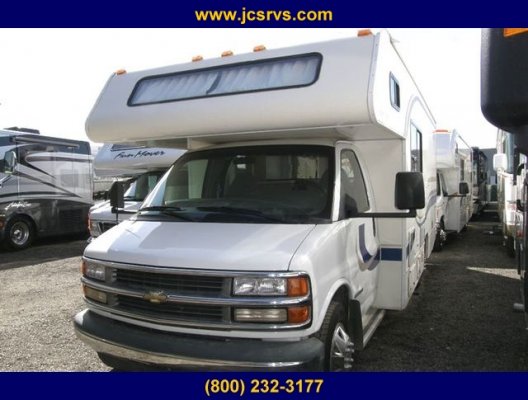 FrontOutside.jpg119.1 KB · Views: 55
FrontOutside.jpg119.1 KB · Views: 55 -
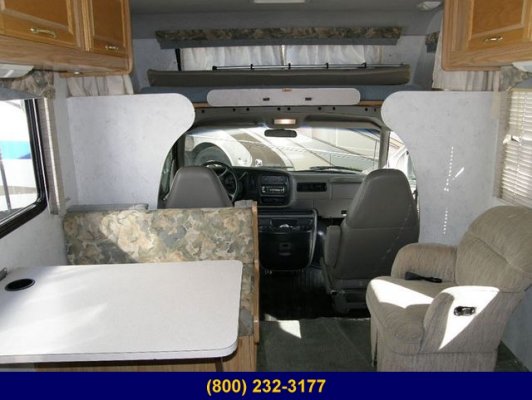 Frontinside.jpg105 KB · Views: 40
Frontinside.jpg105 KB · Views: 40 -
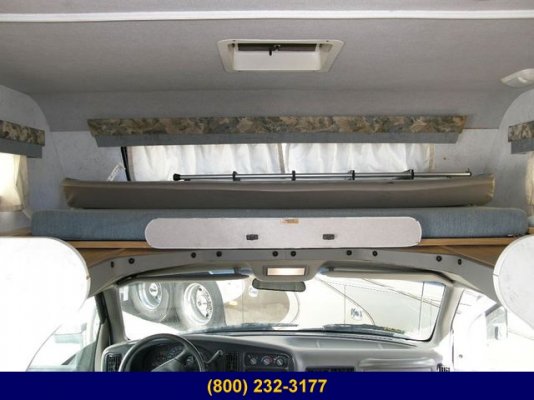 abovecab.jpg100.2 KB · Views: 32
abovecab.jpg100.2 KB · Views: 32 -
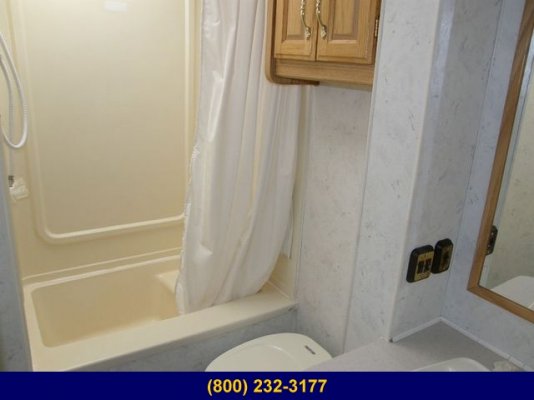 bathroom.jpg71.9 KB · Views: 30
bathroom.jpg71.9 KB · Views: 30 -
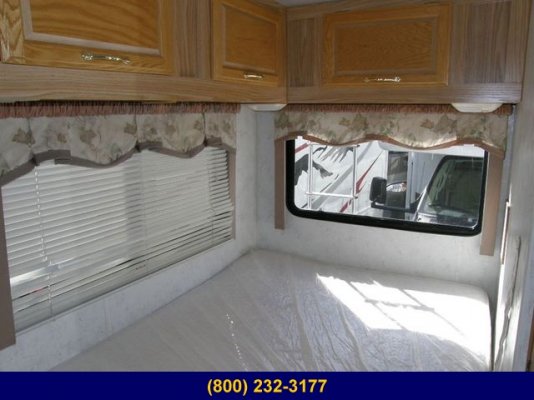 rearbed.jpg103.2 KB · Views: 34
rearbed.jpg103.2 KB · Views: 34 -
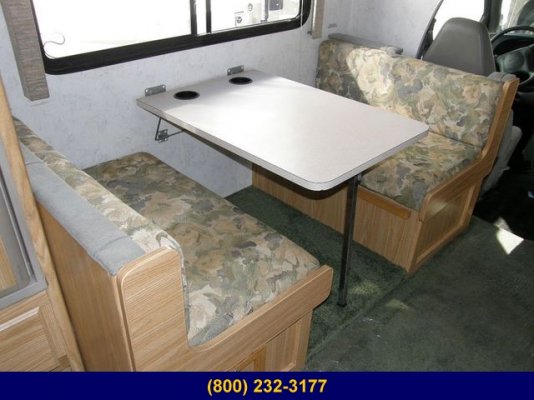 dining.jpg110.7 KB · Views: 28
dining.jpg110.7 KB · Views: 28 -
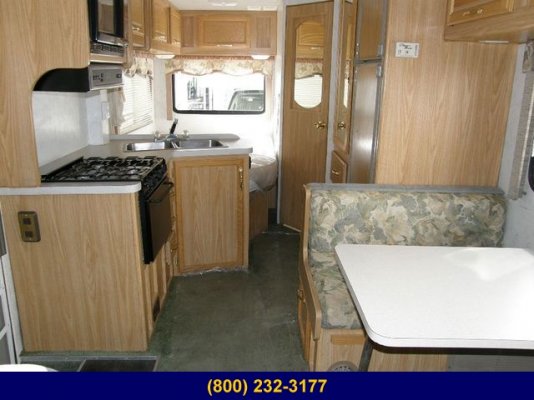 rearinside.jpg111.7 KB · Views: 30
rearinside.jpg111.7 KB · Views: 30 -
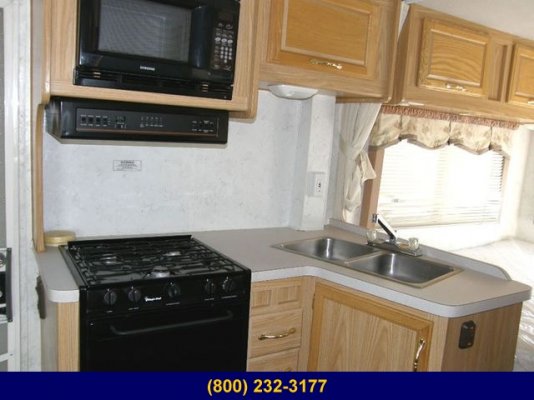 sinkstovemw.jpg105.4 KB · Views: 30
sinkstovemw.jpg105.4 KB · Views: 30 -
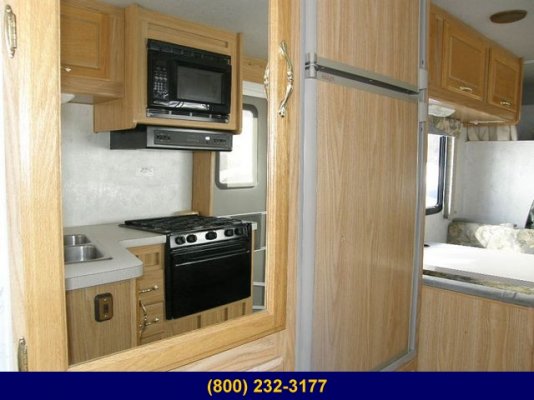 stovefriMW.JPG110.2 KB · Views: 28
stovefriMW.JPG110.2 KB · Views: 28
regularguy
Well-known member
Nice looking rig! Here is the video that someone referred to. It is very informative...
http://www.rvforum.net/index.php?option=com_content&task=view&id=178&Itemid=41
http://www.rvforum.net/index.php?option=com_content&task=view&id=178&Itemid=41
DonTom
Well-known member
regularguy said:Nice looking rig! Here is the video that someone referred to. It is very informative...
http://www.rvforum.net/index.php?option=com_content&task=view&id=178&Itemid=41
Thanks. It was interesting to watch. I just wonder if it is always as easy as they make it look!
-Don- (Reno, NV)
Tom
Administrator
- Joined
- Jan 13, 2005
- Posts
- 51,913
Don,
In the event of a blowout, just be sure Tom is ready to deploy the boat anchor off the stern ;D
BTW did I read that just sold your RV?
In the event of a blowout, just be sure Tom is ready to deploy the boat anchor off the stern ;D
BTW did I read that just sold your RV?
Re Tyron vs Pressure Pro
After I had a front wheel blowout I invested in Pressure Pro, and it has been a mostly positive experience (I still have one sensor position that won't work, though PP has been very helpful).
But, I don't believe it will save me from all blowouts, only those that are due to running a tire underinflated. I'm not sure of the numbers, but many blowouts are due to belt damage caused by hitting potholes or debris at speed, which was what happened to us. We hit a huge pothole at speed in heavy traffic on the I-95, and the tire blew out about four hours later. I did notice a slight tremor in the steering when I took over driving, but wasn't savvy enough to stop and check it. I thought we had just knocked the alignment out a bit. When the tire was examined later, the damage was easily seen from the inside.
I suppose that the tire in question might have overheated and had HIGHER pressure than normal, but the high pressure alarm on PP is (I think) 30% above the set value (it's not in the manual, but I think someone said that on this forum), so might not alarm.
So I'm not counting on PP to save me from ALL blowouts. The video mentioned above is really excellent, and I have watched it several times. It's either on the Michelin or Goodyear site. I did ok last time by not braking until we were under control, and I'm hoping I will have the sense to accelerate next time, but it is so counter-intuitive I may not do it as a first response. I have told my brain to do it but it doesn't always do what I tell it.
Rankjo
After I had a front wheel blowout I invested in Pressure Pro, and it has been a mostly positive experience (I still have one sensor position that won't work, though PP has been very helpful).
But, I don't believe it will save me from all blowouts, only those that are due to running a tire underinflated. I'm not sure of the numbers, but many blowouts are due to belt damage caused by hitting potholes or debris at speed, which was what happened to us. We hit a huge pothole at speed in heavy traffic on the I-95, and the tire blew out about four hours later. I did notice a slight tremor in the steering when I took over driving, but wasn't savvy enough to stop and check it. I thought we had just knocked the alignment out a bit. When the tire was examined later, the damage was easily seen from the inside.
I suppose that the tire in question might have overheated and had HIGHER pressure than normal, but the high pressure alarm on PP is (I think) 30% above the set value (it's not in the manual, but I think someone said that on this forum), so might not alarm.
So I'm not counting on PP to save me from ALL blowouts. The video mentioned above is really excellent, and I have watched it several times. It's either on the Michelin or Goodyear site. I did ok last time by not braking until we were under control, and I'm hoping I will have the sense to accelerate next time, but it is so counter-intuitive I may not do it as a first response. I have told my brain to do it but it doesn't always do what I tell it.
Rankjo
Gary RV_Wizard
Site Team
They tell me it has a 72 gallon gas tank (can that be true)?
I suppose it COULD be, but I wouldn't bet on it. The current Chevy van cutaway chassis comes with a 31 gallon tank and it seems unlikely that even an optional larger tank would be more than 40-50 gallons. Heck, the Class A gas chassis comes with 75 gallons.
DonTom
Well-known member
Tom said:Don,
In the event of a blowout, just be sure Tom is ready to deploy the boat anchor off the stern ;D
BTW did I read that just sold your RV?
I never sell much of anything. Especially not vehicles. I run them until they are not worth repairing. In my old 1978 RV , the engine broke a rod. That thing had a junky 400 CID small block engine. Our "new" RV has a Chevy 454, which is a lot more reliable.
BTW, I hear there's been a lot of serious problems with the Ford V-10. Many such stories in this forum? It seems silly to make an engine smaller than the reliable 460 but put more parts in it.
-Don- (Reno, NV)
DonTom
Well-known member
rankjo said:Re Tyron vs Pressure Pro
After I had a front wheel blowout I invested in Pressure Pro, and it has been a mostly positive experience (I still have one sensor position that won't work, though PP has been very helpful).
But, I don't believe it will save me from all blowouts, only those that are due to running a tire underinflated. I'm not sure of the numbers, but many blowouts are due to belt damage caused by hitting potholes or debris at speed, which was what happened to us. We hit a huge pothole at speed in heavy traffic on the I-95, and the tire blew out about four hours later. I did notice a slight tremor in the steering when I took over driving, but wasn't savvy enough to stop and check it. I thought we had just knocked the alignment out a bit. When the tire was examined later, the damage was easily seen from the inside.
I suppose that the tire in question might have overheated and had HIGHER pressure than normal, but the high pressure alarm on PP is (I think) 30% above the set value (it's not in the manual, but I think someone said that on this forum), so might not alarm.
So I'm not counting on PP to save me from ALL blowouts. The video mentioned above is really excellent, and I have watched it several times. It's either on the Michelin or Goodyear site. I did ok last time by not braking until we were under control, and I'm hoping I will have the sense to accelerate next time, but it is so counter-intuitive I may not do it as a first response. I have told my brain to do it but it doesn't always do what I tell it.
Rankjo
I too wonder if it's as easy as it sounds. But if you're already in a safe place to stop, I would think slowing down very slowly should be fine as you have to do that regardless if you speed up at first or not.
I am going to assume that if PP decided for it to alarm at 30% over-inflation, there was a reason, such as that's where it's still safe on the hottest day in the desert. It cannot alarm too low because it's normal for tire pressure to increase when hot. That's why the tire pressure should be checked when cold. I guess we will never know, but it's very possible that your tire was well over that 30% just before it blew out.
I just checked the PP website and it looks like the PP system with six sensors & a bracket to mount the thing cost about $1,000.00. I tried to click on the "add to basket" but it seems that section of their webiste isn't working at this time. Maybe I will try again later. I assume it will work for most blow outs and will give you some handy information even if it doesn't.
But I do have a question. Is it accurate enough to use as a tire gauge? Does it really mean you never have to check your tires any other way? If so, you sold me and I will order one.
And do most RVer's carry an air compressor, in case you want to fill up the tires? What's a good one for RV use that won't take all day to fill up a tire to RV tire type pressures?
-Don- (Reno, NV)
Tom
Administrator
- Joined
- Jan 13, 2005
- Posts
- 51,913
Don,
Try the PP vendor on this page and let him know you're a forum member.
Many folks rely on the PP as their only gauge. At the beginning of a trip I usually check the pressures with a truck gauge before screwing on the sensors. Last trip, the truck gauge was showing all my tires way low. A second gauge said they were OK. Screwed on the PP sensors and they read pretty close to what the second gauge read. I kicked each tire, and decided it was 3 against one and the first gauge was bad.
In our case we have a diesel coach, so it has an on-board compressor. If it didn't, I'd be inclined to carry a separate compressor.
Try the PP vendor on this page and let him know you're a forum member.
Many folks rely on the PP as their only gauge. At the beginning of a trip I usually check the pressures with a truck gauge before screwing on the sensors. Last trip, the truck gauge was showing all my tires way low. A second gauge said they were OK. Screwed on the PP sensors and they read pretty close to what the second gauge read. I kicked each tire, and decided it was 3 against one and the first gauge was bad.
In our case we have a diesel coach, so it has an on-board compressor. If it didn't, I'd be inclined to carry a separate compressor.
DonTom
Well-known member
Ned said:The overpressure alert for the Pressure Pro is user settable from off to +45% in steps.
They say on their website that they program it for the tires on your vehicle. So perhaps the value that is correct varies with different tires and vehicles.
-Don-
BernieD
Well-known member
DonTom said:They say on their website that they program it for the tires on your vehicle. So perhaps the value that is correct varies with different tires and vehicles.
Don
To the best of my knowledge, all new sensors come programmed to signal at 30% over pressure. The only difference between tires and vehicles would be based on the difference in psi reported.
Carl L
Moderator Emeritus
DonTom said:But I would like to hear from those here who have experienced front tire blowouts at freeway speeds. What usually happens? I know you're supposed to keep the speed up at first and then very slowly come to a stop. Might be easier said than done.
Easier to handle than a rear tire blowout. You can steer the front wheels. For a complete rundown click HERE
DonTom
Well-known member
"Easier to handle than a rear tire blowout."
Even when there's dual tires on each side in the rear? I have experienced two blow outs in my life. Both times in the rear. One had single rear tires, the other had dual.
BTW, when an engine blows a rod, it feels just like a blow out. I would say there's even more shaking than a blowout. I have experienced that TWICE (once in a 3/4 ton Class B and another time in a 22 foot one ton <sounds like a Chinese soup!> van, Class C). Both times was when going down hill. The only other difference is that the engine usually dies (but not always) when a piston rod breaks.
I just realized it was in the same two vehicles above that had the rear tire blowouts. There was no real difficulty either time. I would say both vehicles were harder to control when the piston rod broke.
But I have never experienced a front tire blow-out so I wondered what it would be like. Seems like it may not be such a big deal as long as there's no panic.
I was just thinking (danger!). I would think if the cruise control is on and you get a blow out, just do nothing except for turn the cruise control off when safe and coast to a stop. I would think that would slow down at about the correct speed. Does that sound correct?
Even when there's dual tires on each side in the rear? I have experienced two blow outs in my life. Both times in the rear. One had single rear tires, the other had dual.
BTW, when an engine blows a rod, it feels just like a blow out. I would say there's even more shaking than a blowout. I have experienced that TWICE (once in a 3/4 ton Class B and another time in a 22 foot one ton <sounds like a Chinese soup!> van, Class C). Both times was when going down hill. The only other difference is that the engine usually dies (but not always) when a piston rod breaks.
I just realized it was in the same two vehicles above that had the rear tire blowouts. There was no real difficulty either time. I would say both vehicles were harder to control when the piston rod broke.
But I have never experienced a front tire blow-out so I wondered what it would be like. Seems like it may not be such a big deal as long as there's no panic.
I was just thinking (danger!). I would think if the cruise control is on and you get a blow out, just do nothing except for turn the cruise control off when safe and coast to a stop. I would think that would slow down at about the correct speed. Does that sound correct?
-Don- South San Francisco, CA
